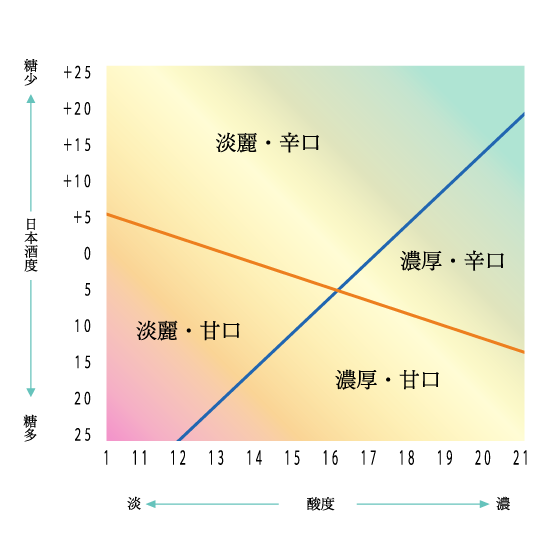Brewed liquor is +5-10 super dry
The sweet sensation is the illusion of fragrance
Sake’s sweetness…Sake does not contain spicy ingredients
Sake is brewed from rice and water.
The main ingredient of rice is starch.
Only after being decomposed into glucose by the enzyme of koji,
It will be recognized as a sweet sugar.
On the 6th day from the start of fermentation, it will be in the 50th place.
In theory, one molecule of alcohol can be made with two sugar molecules,
Actually, due to volatilization of alcohol
It is a pure rice liquor with an alcohol content of about 18 degrees.
It can be set to about 5 to +5 with a sake gravimeter.
The sweetness and dryness are represented by the degree of sake = specific gravity meter.
A gravimeter called Sake degree is floated on sake kept at 15 degrees.
Sake with a lot of sugar = sweetness is displayed as a floating minus,
Sake with low sugar = dry, it is displayed as plus sink.
However, since the sweetness and sourness cancel each other out,
In terms of taste, at the starting point=0, it is not a right angle,
It feels like the graph below.
Sake with low sugar content is called dry.
 The clearer the taste of the material, the more you live
The clearer the taste of the material, the more you live
The synergistic effect of umami. Glutamic acid/Inosine acid
| 和の食材 | 洋の食材 | 中華の食材 | |
| グルタミン酸 | 昆布 漬け物 | トマト・ネギ・セロリ | ショウガ・ネギ |
| イノシン酸 | 鰹節 | 肉 | 鶏肉 |
Synergistic effect: The ratio of glutamic acid/inosinic acid. The best ratio is 50% each.
About sake and saltines
As well as sake, sake that has a “salty taste”
Not found in sake, wine, beer, shochu, whiskey, brandy, etc.
Sake with strong taste, sweetness, sourness and bitterness has a strong saltiness,
For sweet, astringent and sour wines, umami and salty cheese.
Alcohol, such as whiskey and brandy, where the sweetness of alcohol is the main ingredient,
Astringent and sweet chocolate, umami and salty beef jerky, etc. match.
“Forbidden taste” = There is a pleasant sensation by eliminating the excessively strong taste from the taste.